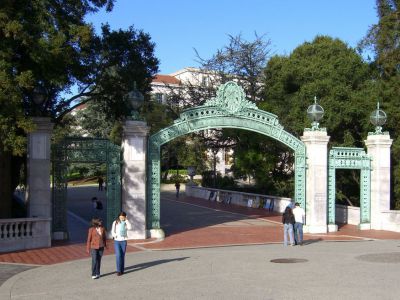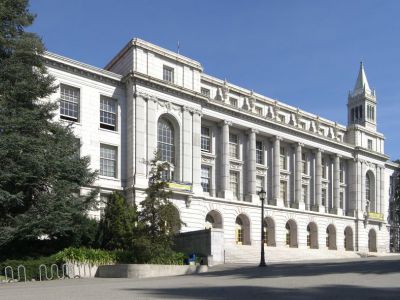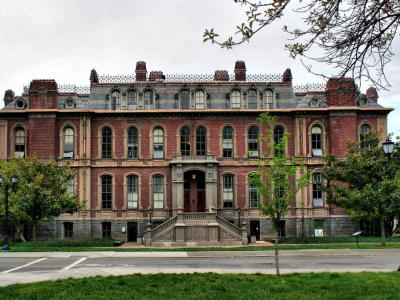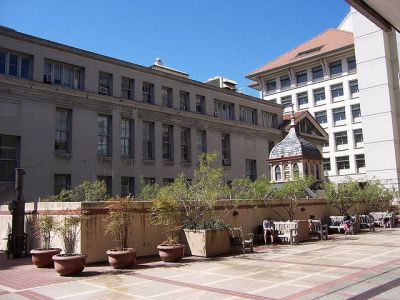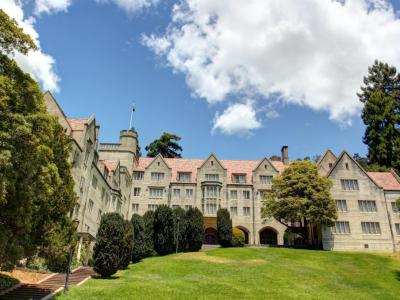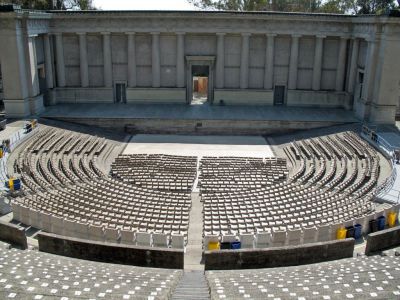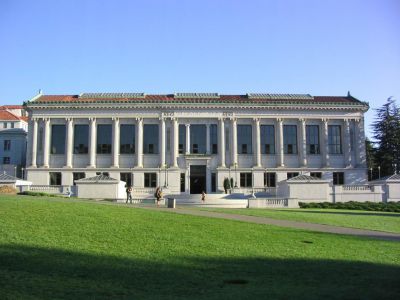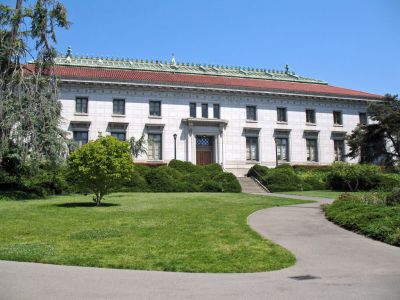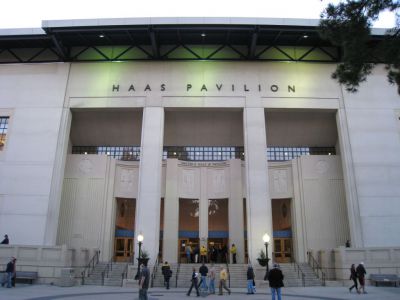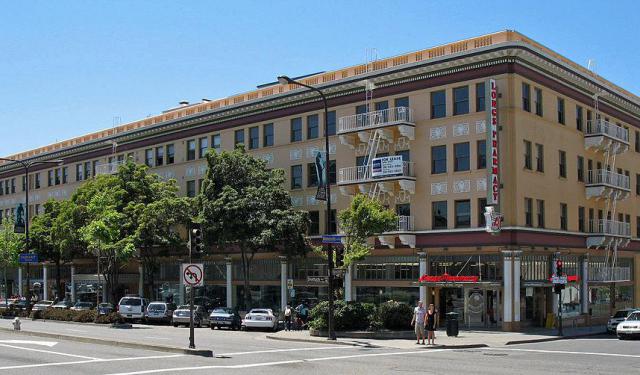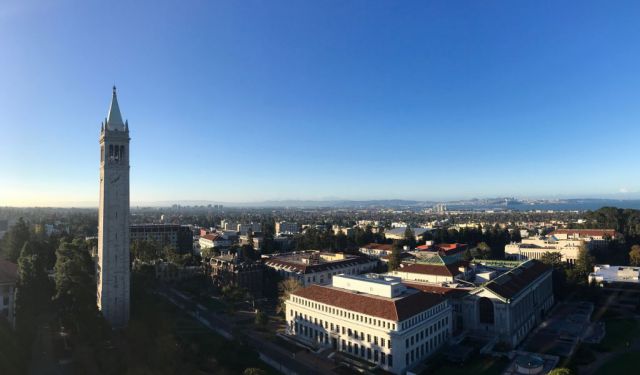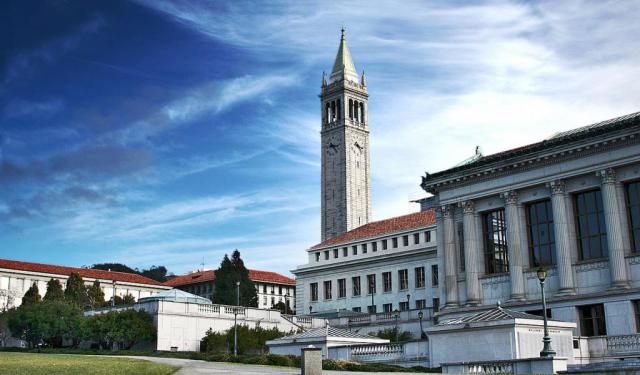
University of California in Berkeley Walking Tour (Self Guided), Berkeley
The University of California, Berkeley, often referred to as UC Berkeley or simply Berkeley, is a part of the larger University of California system, known for its distinguished academics and vibrant campus life. The UC Berkeley campus is the core of Berkeley's attractions. Its design resulted from an 1898 architectural competition, with each building having its own story to tell.
Start your walk at Sather Gate, an iconic entrance on campus, that throughout decades has welcomed numerous generations of students and visitors alike as a symbol of academic pursuit and achievement. Nearby, Wheeler Hall and South Hall are prominent academic buildings where students attend classes and engage in intellectual exploration.
Sather Tower, affectionately known as the Campanile, is a majestic clock tower that offers panoramic views of the Bay Area. Gilman Hall is another notable building, housing various research facilities.
The Haas School of Business is a hub for aspiring entrepreneurs and business leaders, while Bowles Hall provides a unique residential experience, fostering a sense of community.
The Hearst Greek Theatre is a stunning outdoor venue for concerts and performances. Founders' Rock and Memorial Glade are tranquil spots for reflection and relaxation.
Doe Memorial Library is the heart of academic research, while California Hall is home to the university's administration.
Those keen on sports should check out Haas Pavilion which regularly hosts student games, whereas the Eucalyptus Grove provides a serene backdrop to campus life.
Berkeley is a place where ideas flourish and diversity thrives. If you're considering higher education or just looking to visit, come and become part of the tradition, innovation, and excellence at UC Berkeley – an inspiring experience you wouldn't want to miss!
Start your walk at Sather Gate, an iconic entrance on campus, that throughout decades has welcomed numerous generations of students and visitors alike as a symbol of academic pursuit and achievement. Nearby, Wheeler Hall and South Hall are prominent academic buildings where students attend classes and engage in intellectual exploration.
Sather Tower, affectionately known as the Campanile, is a majestic clock tower that offers panoramic views of the Bay Area. Gilman Hall is another notable building, housing various research facilities.
The Haas School of Business is a hub for aspiring entrepreneurs and business leaders, while Bowles Hall provides a unique residential experience, fostering a sense of community.
The Hearst Greek Theatre is a stunning outdoor venue for concerts and performances. Founders' Rock and Memorial Glade are tranquil spots for reflection and relaxation.
Doe Memorial Library is the heart of academic research, while California Hall is home to the university's administration.
Those keen on sports should check out Haas Pavilion which regularly hosts student games, whereas the Eucalyptus Grove provides a serene backdrop to campus life.
Berkeley is a place where ideas flourish and diversity thrives. If you're considering higher education or just looking to visit, come and become part of the tradition, innovation, and excellence at UC Berkeley – an inspiring experience you wouldn't want to miss!
How it works: Download the app "GPSmyCity: Walks in 1K+ Cities" from Apple App Store or Google Play Store to your mobile phone or tablet. The app turns your mobile device into a personal tour guide and its built-in GPS navigation functions guide you from one tour stop to next. The app works offline, so no data plan is needed when traveling abroad.
University of California in Berkeley Walking Tour Map
Guide Name: University of California in Berkeley Walking Tour
Guide Location: USA » Berkeley (See other walking tours in Berkeley)
Guide Type: Self-guided Walking Tour (Sightseeing)
# of Attractions: 14
Tour Duration: 2 Hour(s)
Travel Distance: 3.1 Km or 1.9 Miles
Author: AudreyB
Sight(s) Featured in This Guide:
Guide Location: USA » Berkeley (See other walking tours in Berkeley)
Guide Type: Self-guided Walking Tour (Sightseeing)
# of Attractions: 14
Tour Duration: 2 Hour(s)
Travel Distance: 3.1 Km or 1.9 Miles
Author: AudreyB
Sight(s) Featured in This Guide:
- Sather Gate
- Wheeler Hall
- South Hall
- Sather Tower
- Gilman Hall
- Haas School of Business
- Bowles Hall
- Hearst Greek Theatre
- Founders' Rock
- Memorial Glade
- Doe Memorial Library
- California Hall
- Haas Pavilion
- Eucalyptus Grove, UC Berkeley
1) Sather Gate (must see)
Walking to the center of the University of California Berkeley from Sproul Plaza, visitors will find themselves at Sather Gate. Most will have undoubtedly seen photographs of Sather Gate from the 1960s Free Speech movement.
Sather Gate, like Sather Tower, was a gift to the University of California Berkeley from Jane Sather. She donated the funding for the gate in memory of her late husband, Peder Sather. This gate was built in 1910 in the Classical Revival Beaux-Arts architectural style from a design by John Galen Howard and sculptor Earl Cummings.
Cummings originally designed the gate with panels that depicted nude men and women who represented different areas of study. The panels were scandalous at the time and were removed by request of the benefactor. Those panels went missing until 1977 when they were discovered in a storage area beneath Edwards Stadium. Student petitions led to the panels being reinstalled on the gates, where they have been since 1979.
The gate is on the National Register of Historic Places and is a California Historical Landmark.
Sather Gate, like Sather Tower, was a gift to the University of California Berkeley from Jane Sather. She donated the funding for the gate in memory of her late husband, Peder Sather. This gate was built in 1910 in the Classical Revival Beaux-Arts architectural style from a design by John Galen Howard and sculptor Earl Cummings.
Cummings originally designed the gate with panels that depicted nude men and women who represented different areas of study. The panels were scandalous at the time and were removed by request of the benefactor. Those panels went missing until 1977 when they were discovered in a storage area beneath Edwards Stadium. Student petitions led to the panels being reinstalled on the gates, where they have been since 1979.
The gate is on the National Register of Historic Places and is a California Historical Landmark.
2) Wheeler Hall (must see)
Wheeler Hall is arguably the most recognizable building on the University of California Berkeley campus. It is the site that is often featured in representations of the university and the building that houses Berkeley's largest lecture hall. It is home to the university's English department.
Wheeler Hall is designed in the Classical Revival architectural style by architect John Galen Howard. His designs are seen throughout the Berkeley campus, including Sather Tower, Sather Gate and the Memorial Stadium. Wheeler Hall was completed in 1917 to take place of North Hall. The cost of construction was $715,994.
The building was closed in recent years in order to undergo a complete operational transformation. The facade was not changed, but Wheeler Hall was retrofitted with air conditioning, elevators and wireless communication.
Wheeler Hall has undergone a number of other updates and restorations over time. Great pains have been taken to ensure that all historic details have been preserved throughout these projects. Rather than replacing features of the building, many have been refurbished. One exception to this is the auditorium. The original was built in March 1917 but was destroyed by an arsonist in 1969.
Stopping by the iconic Wheeler Hall steps brings back images of Free Speech protests from the 1960s. Visitors can also imagine speeches by great figures from history like Dr. Martin Luther King, Jr. The hall is easy to reach by foot as it is located just steps away from Sather Gate and south of Doe Library.
Wheeler Hall is designed in the Classical Revival architectural style by architect John Galen Howard. His designs are seen throughout the Berkeley campus, including Sather Tower, Sather Gate and the Memorial Stadium. Wheeler Hall was completed in 1917 to take place of North Hall. The cost of construction was $715,994.
The building was closed in recent years in order to undergo a complete operational transformation. The facade was not changed, but Wheeler Hall was retrofitted with air conditioning, elevators and wireless communication.
Wheeler Hall has undergone a number of other updates and restorations over time. Great pains have been taken to ensure that all historic details have been preserved throughout these projects. Rather than replacing features of the building, many have been refurbished. One exception to this is the auditorium. The original was built in March 1917 but was destroyed by an arsonist in 1969.
Stopping by the iconic Wheeler Hall steps brings back images of Free Speech protests from the 1960s. Visitors can also imagine speeches by great figures from history like Dr. Martin Luther King, Jr. The hall is easy to reach by foot as it is located just steps away from Sather Gate and south of Doe Library.
3) South Hall (must see)
The oldest building on the University of California Berkeley campus is South Hall. It is also the only building that is original to the university that is still standing today. South Hall was completed in 1973 from a design by Farquharson and Kenitzer in the Second Empire architectural style.
South Hall has served a number of functions over the years. Its first purpose was as the home of the School of Agriculture. Over time, it also hosted the business school, the economics department, the School of Political Science and Sociology, the library school, a museum and an herbarium. It was also the location of the country's first physics lab.
South Hall is still in use as part of Berkeley's graduate school. The Berkeley School of Information is housed in South Hall and is comprised of classrooms, student lounges and work spaces. It has been reconfigured to allow for built-in projectors, audio equipment and wifi.
South Hall has served a number of functions over the years. Its first purpose was as the home of the School of Agriculture. Over time, it also hosted the business school, the economics department, the School of Political Science and Sociology, the library school, a museum and an herbarium. It was also the location of the country's first physics lab.
South Hall is still in use as part of Berkeley's graduate school. The Berkeley School of Information is housed in South Hall and is comprised of classrooms, student lounges and work spaces. It has been reconfigured to allow for built-in projectors, audio equipment and wifi.
4) Sather Tower (must see)
The bell tower on the University of California Berkeley campus is called Sather Tower. It was a gift from Jane K. Sather in memory of her husband, Peder. He was a prominent banker and a trustee of the university.
Jane Sather was a well known suffragist and philanthropist. She was a major benefactor in the early days of the Berkeley campus, providing donations in both land and money. The initial $75,000 she gave to the University would be the equivalent of nearly $2 million in today's fund. Sather Tower was an even more robust donation. The $200,000 price tag for the tower translates to more than $5 million in today's rates.
Sather Tower is a Gothic Revival style bell tower with clocks on all four faces. It was designed by architect John Galen Howard who modeled it after the Saint Mark's Square Campanile in Venice. It is the third tallest clock tower in the world and the tallest bell tower outside of Italy, standing at 307 feet tall. There is an observation deck on the tower's eighth floor that has views of San Francisco and the Golden Gate Bridge.
The tower originally held a 12-bell chime. It has been expanded over the years and now contains a 61-bell, full concert carillon. It is performed on regular intervals during the spring and fall semesters and irregularly throughout the rest of the year. The Department of Music at Berkeley offers carillon classes to those who can pass the rigorous musical audition.
Many fossils, particularly those found at the La Brea Tar Pits, are stored within the tower.
Why You Should Visit:
- To see the tallest bell tower in the world outside of Italy
- To take in the views of San Francisco
Tips:
The cost to visit Sather Tower is $4 for each person over the age of 17. Children are free. There is no need to worry about climbing steps to get to the observation deck as there is an elevator inside that will take tourists to the eighth floor.
Jane Sather was a well known suffragist and philanthropist. She was a major benefactor in the early days of the Berkeley campus, providing donations in both land and money. The initial $75,000 she gave to the University would be the equivalent of nearly $2 million in today's fund. Sather Tower was an even more robust donation. The $200,000 price tag for the tower translates to more than $5 million in today's rates.
Sather Tower is a Gothic Revival style bell tower with clocks on all four faces. It was designed by architect John Galen Howard who modeled it after the Saint Mark's Square Campanile in Venice. It is the third tallest clock tower in the world and the tallest bell tower outside of Italy, standing at 307 feet tall. There is an observation deck on the tower's eighth floor that has views of San Francisco and the Golden Gate Bridge.
The tower originally held a 12-bell chime. It has been expanded over the years and now contains a 61-bell, full concert carillon. It is performed on regular intervals during the spring and fall semesters and irregularly throughout the rest of the year. The Department of Music at Berkeley offers carillon classes to those who can pass the rigorous musical audition.
Many fossils, particularly those found at the La Brea Tar Pits, are stored within the tower.
Why You Should Visit:
- To see the tallest bell tower in the world outside of Italy
- To take in the views of San Francisco
Tips:
The cost to visit Sather Tower is $4 for each person over the age of 17. Children are free. There is no need to worry about climbing steps to get to the observation deck as there is an elevator inside that will take tourists to the eighth floor.
5) Gilman Hall
Gilman Hall, situated on the University of California, Berkeley campus, is a cornerstone of scientific history and a designated National Historic Landmark. Built between 1916 and 1917 under the guidance of Gilbert N. Lewis, the building was designed by architect John Galen Howard to accommodate the College of Chemistry’s growing needs. Named for Daniel Coit Gilman, the university’s president from 1872 to 1875, Gilman Hall served as a hub for groundbreaking research in physical, inorganic, and nuclear chemistry.
Room 307 in Gilman Hall is where Glenn T. Seaborg and his team identified plutonium on February 23, 1941, a discovery that earned the building its National Historic Chemical Landmark status. During World War II, the attic was used for classified Manhattan Project research, with lab upgrades like powered fume hood fans to support the work.
The hall has produced two Nobel Prizes in Chemistry: William Giauque’s 1949 recognition for his work on matter at temperatures near absolute zero and Glenn T. Seaborg’s 1951 prize for discoveries in transuranium elements. Additionally, four other researchers associated with Gilman Hall have received Nobel Prizes for later work, solidifying its legacy as a beacon of scientific achievement.
In the late 20th century, the Department of Energy remediated contamination from past nuclear research under FUSRAP, bringing Gilman Hall to modern safety standards. Now housing the Department of Chemical and Biomolecular Engineering, the building has been renovated for offices, classrooms, and small labs.
With over 80 years of continuous use, Gilman Hall remains a symbol of scientific innovation and a testament to the University of California, Berkeley’s contributions to chemistry and beyond.
Room 307 in Gilman Hall is where Glenn T. Seaborg and his team identified plutonium on February 23, 1941, a discovery that earned the building its National Historic Chemical Landmark status. During World War II, the attic was used for classified Manhattan Project research, with lab upgrades like powered fume hood fans to support the work.
The hall has produced two Nobel Prizes in Chemistry: William Giauque’s 1949 recognition for his work on matter at temperatures near absolute zero and Glenn T. Seaborg’s 1951 prize for discoveries in transuranium elements. Additionally, four other researchers associated with Gilman Hall have received Nobel Prizes for later work, solidifying its legacy as a beacon of scientific achievement.
In the late 20th century, the Department of Energy remediated contamination from past nuclear research under FUSRAP, bringing Gilman Hall to modern safety standards. Now housing the Department of Chemical and Biomolecular Engineering, the building has been renovated for offices, classrooms, and small labs.
With over 80 years of continuous use, Gilman Hall remains a symbol of scientific innovation and a testament to the University of California, Berkeley’s contributions to chemistry and beyond.
6) Haas School of Business
The Walter A. Haas School of Business, commonly known as Berkeley Haas, stands as one of the most prestigious business schools in the world and the first of its kind at a public university in the United States. Founded in 1898 as the College of Commerce at the University of California, Berkeley, Haas has consistently pushed the boundaries of business education, blending rigorous academic traditions with innovative programs.
Situated in a modern complex of four interconnected buildings surrounding a central courtyard on the southeastern corner of the Berkeley campus, Haas provides a dynamic learning environment for both undergraduate and graduate students. The school’s programs are deeply rooted in collaboration and diversity, with its undergraduate business administration program admitting approximately 700 students annually. The curriculum is built on teamwork, fostering a close-knit community of future leaders equipped with the skills and knowledge to thrive in the global business landscape.
Berkeley Haas has a rich history of innovation, integrating commerce education with a liberal arts foundation. Over time, it expanded its programs, including MBA and doctoral offerings, and established renowned research centers. A transformative 1989 donation from Walter and Elise Haas led to the school’s renaming.
Berkeley Haas is a hub of intellectual prowess, with faculty that includes Nobel laureates, former Federal Reserve Chairs, and industry leaders. Its alumni network is a testament to its influence, producing trailblazers across sectors. The school’s impact extends beyond academics, housing the Berkeley SkyDeck startup incubator in Downtown Berkeley, which nurtures entrepreneurial ventures and innovation.
As the second-oldest business school in the United States, Berkeley Haas continues to shape the future of business with its commitment to knowledge, leadership, and collaboration. Its motto, "Question the Status Quo," encapsulates the school’s ethos of challenging conventional thinking and driving positive change in the world.
Situated in a modern complex of four interconnected buildings surrounding a central courtyard on the southeastern corner of the Berkeley campus, Haas provides a dynamic learning environment for both undergraduate and graduate students. The school’s programs are deeply rooted in collaboration and diversity, with its undergraduate business administration program admitting approximately 700 students annually. The curriculum is built on teamwork, fostering a close-knit community of future leaders equipped with the skills and knowledge to thrive in the global business landscape.
Berkeley Haas has a rich history of innovation, integrating commerce education with a liberal arts foundation. Over time, it expanded its programs, including MBA and doctoral offerings, and established renowned research centers. A transformative 1989 donation from Walter and Elise Haas led to the school’s renaming.
Berkeley Haas is a hub of intellectual prowess, with faculty that includes Nobel laureates, former Federal Reserve Chairs, and industry leaders. Its alumni network is a testament to its influence, producing trailblazers across sectors. The school’s impact extends beyond academics, housing the Berkeley SkyDeck startup incubator in Downtown Berkeley, which nurtures entrepreneurial ventures and innovation.
As the second-oldest business school in the United States, Berkeley Haas continues to shape the future of business with its commitment to knowledge, leadership, and collaboration. Its motto, "Question the Status Quo," encapsulates the school’s ethos of challenging conventional thinking and driving positive change in the world.
7) Bowles Hall
Bowles Hall, nestled on the University of California, Berkeley campus, is a historic residential college with a legacy of tradition, camaraderie, and spirited student life. Designed by George W. Kelham, this iconic Collegiate Gothic structure holds the distinction of being the first state-owned residence hall in California, officially opening in 1929. Its creation was made possible by a $350,000 grant from Mary McNear Bowles, in memory of her husband, UC Regent and alumnus Phillip E. Bowles, who cherished horses, horticulture, and his alma mater.
Originally a male-only residence, Bowles Hall was renowned for its fraternity-like atmosphere, reinforced by partitioned four-man rooms, expansive common areas, and exclusive traditions practiced by the "Bowlesmen." The building’s striking architecture, featuring a pale stone façade, five-arch entry arcade, and crenelated tower, earned it a place on the National Register of Historic Places in 1989 and designation as a City of Berkeley landmark in 1988.
Bowles Hall underwent a 14-month restoration and reopened in August 2016 as a coeducational residential college. The project, led by former residents through a public-private partnership, modernized the facilities while preserving its historic charm. The updated design features eight levels of two-room suites and common areas, now housing four students per suite.
A noteworthy feature of Bowles Hall is the Julien and Helen Hart Memorial Library, added in 1939 through a gift from their family. The library’s namesake, James D. Hart, was a UC Berkeley English professor and editor of the Oxford Handbook of American Literature. The building itself also sits atop the Hayward Fault, adding a unique geological dimension to its significance.
The hall’s rich history, architectural splendor, and enduring sense of community continue to make it a beloved institution at Berkeley.
Originally a male-only residence, Bowles Hall was renowned for its fraternity-like atmosphere, reinforced by partitioned four-man rooms, expansive common areas, and exclusive traditions practiced by the "Bowlesmen." The building’s striking architecture, featuring a pale stone façade, five-arch entry arcade, and crenelated tower, earned it a place on the National Register of Historic Places in 1989 and designation as a City of Berkeley landmark in 1988.
Bowles Hall underwent a 14-month restoration and reopened in August 2016 as a coeducational residential college. The project, led by former residents through a public-private partnership, modernized the facilities while preserving its historic charm. The updated design features eight levels of two-room suites and common areas, now housing four students per suite.
A noteworthy feature of Bowles Hall is the Julien and Helen Hart Memorial Library, added in 1939 through a gift from their family. The library’s namesake, James D. Hart, was a UC Berkeley English professor and editor of the Oxford Handbook of American Literature. The building itself also sits atop the Hayward Fault, adding a unique geological dimension to its significance.
The hall’s rich history, architectural splendor, and enduring sense of community continue to make it a beloved institution at Berkeley.
8) Hearst Greek Theatre
The William Randolph Hearst Greek Theatre, commonly known as the Greek Theatre, is an iconic 8,500-seat outdoor amphitheater situated on the campus of the University of California, Berkeley. Owned and operated by the university, this historic venue has hosted a wide array of cultural, academic, and entertainment events since its opening in 1903.
The Greek Theatre originated from Ben Weed's Amphitheater, a natural gathering spot since 1894. Completed in 1903 under UC Berkeley President Benjamin Ide Wheeler and funded by William Randolph Hearst, it was designed by John Galen Howard with Julia Morgan, inspired by the ancient theater of Epidaurus. Officially opening on September 24, 1903, with a student production of The Birds, it had earlier hosted President Theodore Roosevelt during a graduation ceremony. Additions in 1957 and a 2012 seismic retrofit modernized the structure, which was listed on the National Register of Historic Places in 1982.
The Greek Theatre is set within a natural amphitheater, with its design taking advantage of the hillside's semicircular shape. It features 19 rows of concrete benches arranged in a semi-circle, with a grassy mound at the top for informal seating. The lowest tiers include 28 intricately carved stone chairs. The elevated stage is framed by high walls with Doric columns and an imposing central entrance, styled with classical entablatures and detailed molding.
The Greek Theatre is famed for its diverse events, including the Berkeley Jazz Festival, concerts across genres, UC Berkeley graduations, and speeches by figures like Bishop Desmond Tutu and the Dalai Lama. Legendary artists, including The Grateful Dead with 29 performances between 1967 and 1989, have graced its stage. It also hosts annual traditions like the Bonfire Rally and Charter Day.
Located north of Bowles Hall, the Greek Theatre combines classical design with stunning Western views, making it a beloved landmark for UC Berkeley and the local community.
The Greek Theatre originated from Ben Weed's Amphitheater, a natural gathering spot since 1894. Completed in 1903 under UC Berkeley President Benjamin Ide Wheeler and funded by William Randolph Hearst, it was designed by John Galen Howard with Julia Morgan, inspired by the ancient theater of Epidaurus. Officially opening on September 24, 1903, with a student production of The Birds, it had earlier hosted President Theodore Roosevelt during a graduation ceremony. Additions in 1957 and a 2012 seismic retrofit modernized the structure, which was listed on the National Register of Historic Places in 1982.
The Greek Theatre is set within a natural amphitheater, with its design taking advantage of the hillside's semicircular shape. It features 19 rows of concrete benches arranged in a semi-circle, with a grassy mound at the top for informal seating. The lowest tiers include 28 intricately carved stone chairs. The elevated stage is framed by high walls with Doric columns and an imposing central entrance, styled with classical entablatures and detailed molding.
The Greek Theatre is famed for its diverse events, including the Berkeley Jazz Festival, concerts across genres, UC Berkeley graduations, and speeches by figures like Bishop Desmond Tutu and the Dalai Lama. Legendary artists, including The Grateful Dead with 29 performances between 1967 and 1989, have graced its stage. It also hosts annual traditions like the Bonfire Rally and Charter Day.
Located north of Bowles Hall, the Greek Theatre combines classical design with stunning Western views, making it a beloved landmark for UC Berkeley and the local community.
9) Founders' Rock (must see)
Founders' Rock, located at the corner of Hearst Avenue and Gayley Road in Berkeley, is a historical landmark closely tied to the origins of the University of California. This natural geological outcropping marks the spot where, on April 16, 1860, the trustees of the College of California gathered to dedicate the newly acquired 30-acre property as the future site for their college. This moment laid the groundwork for what would later become the University of California in 1868.
The rock also holds significant cultural importance. In 1866, Frederick H. Billings, inspired by Bishop George Berkeley's verse, "Westward the course of empire takes its way," suggested naming the surrounding area "Berkeley." This poetic choice forever linked the college and city to the philosopher's legacy.
The graduating class of 1896 commemorated this historic site by placing a plaque on Founders' Rock during Charter Day celebrations. Over the years, it has been recognized as a Berkeley Landmark (since 1991), a California Historical Landmark (since 1982), and part of the National Register of Historic Places (since 1982). Its unique geological composition may owe its prominence to ancient seismic activity from the nearby Hayward Fault.
Founders' Rock serves as a tangible reminder of the University of California's early history and the visionary efforts that shaped one of the world’s premier institutions of higher learning.
The rock also holds significant cultural importance. In 1866, Frederick H. Billings, inspired by Bishop George Berkeley's verse, "Westward the course of empire takes its way," suggested naming the surrounding area "Berkeley." This poetic choice forever linked the college and city to the philosopher's legacy.
The graduating class of 1896 commemorated this historic site by placing a plaque on Founders' Rock during Charter Day celebrations. Over the years, it has been recognized as a Berkeley Landmark (since 1991), a California Historical Landmark (since 1982), and part of the National Register of Historic Places (since 1982). Its unique geological composition may owe its prominence to ancient seismic activity from the nearby Hayward Fault.
Founders' Rock serves as a tangible reminder of the University of California's early history and the visionary efforts that shaped one of the world’s premier institutions of higher learning.
10) Memorial Glade
Memorial Glade is a tranquil green space at the heart of the University of California, Berkeley, offering students and visitors a serene environment for relaxation, reflection, and community activities. This expansive open area is framed by diverse greenery, including a grove of trident maples, and provides stunning views of other campus landmarks. Originally part of John Galen Howard’s master plan for the campus, the glade’s design was obscured for decades by temporary structures built during World War II. However, the construction of the underground Gardner Stacks for the university library in 1998 enabled the restoration of this essential space.
The glade is a popular spot for students to unwind between classes, picnic, or enjoy informal gatherings. It also serves as a cultural hub, hosting outdoor lectures, concerts, and events that blend the vibrant energy of campus life with the natural beauty of its surroundings.
At the northwest corner of Memorial Glade lies a poignant memorial pool, dedicated to the members of the campus community who lost their lives during World War II. This reflective element underscores the glade’s historical significance as a place of remembrance and gratitude.
As part of UC Berkeley, a public research university founded in 1868 and recognized as the flagship institution of the University of California system, Memorial Glade embodies the institution’s dedication to innovation, education, and historical preservation. Its harmonious blend of nature, history, and community activity makes it a quintessential part of the Berkeley experience.
The glade is a popular spot for students to unwind between classes, picnic, or enjoy informal gatherings. It also serves as a cultural hub, hosting outdoor lectures, concerts, and events that blend the vibrant energy of campus life with the natural beauty of its surroundings.
At the northwest corner of Memorial Glade lies a poignant memorial pool, dedicated to the members of the campus community who lost their lives during World War II. This reflective element underscores the glade’s historical significance as a place of remembrance and gratitude.
As part of UC Berkeley, a public research university founded in 1868 and recognized as the flagship institution of the University of California system, Memorial Glade embodies the institution’s dedication to innovation, education, and historical preservation. Its harmonious blend of nature, history, and community activity makes it a quintessential part of the Berkeley experience.
11) Doe Memorial Library
The main library on the UC Berkeley campus is Doe Memorial Library. It is located in the center of campus adjacent to Bancroft Library and popular student gathering spot, Memorial Glade.
The library was designed by architect Emile Benard, whose thumbprint can be seen on much of the Berkeley campus. The Neoclassical design of the building is primarily influenced by Benard's time at France's Ecole des Beaux Arts. The library was completed in 1911.
The main stacks of the Doe Memorial Library hold 52 miles books in a four-story underground structure. The library also includes classrooms, offices and exhibit space. It is easy to walk to and from the Bancroft Library from Doe Memorial as the two are connected via walkways on the first and second floors.
The general public is welcome to explore the library while visiting the UC Berkeley campus. However, only students of Berkeley or Stanford University may check out books and equipment. The library is a short walk from Sather Gate and Wheeler Hall.
The library was designed by architect Emile Benard, whose thumbprint can be seen on much of the Berkeley campus. The Neoclassical design of the building is primarily influenced by Benard's time at France's Ecole des Beaux Arts. The library was completed in 1911.
The main stacks of the Doe Memorial Library hold 52 miles books in a four-story underground structure. The library also includes classrooms, offices and exhibit space. It is easy to walk to and from the Bancroft Library from Doe Memorial as the two are connected via walkways on the first and second floors.
The general public is welcome to explore the library while visiting the UC Berkeley campus. However, only students of Berkeley or Stanford University may check out books and equipment. The library is a short walk from Sather Gate and Wheeler Hall.
12) California Hall
California Hall, a distinguished centerpiece of the University of California, Berkeley campus, exemplifies the Beaux-Arts Classical Revival style. It was one of the first buildings realized under the Phoebe Hearst architectural plan, designed by University Architect John Galen Howard. Construction began in 1903, and the building officially opened in August 1905. Since then, it has evolved from its initial use as the university's administrative hub to housing the Chancellor's Office and the Graduate Division today.
The hall's steel frame, sheathed in reinforced concrete and clad with granite from Raymond quarries, highlights Howard's dedication to durability and aesthetics. This granite, known for its hardness and uniformity, was lined with brick for added stability. While granite is not inherently fireproof, California Hall integrated state-of-the-art fireproofing measures, including metal studs, wire lath, and fireproof plaster, a pioneering approach in the early 20th century. A University Chronicle article proudly proclaimed it to be one of the safest buildings in the state.
The roof, crafted from concrete-sheathed steel and adorned with Spanish mission tiles (tejas), underscores Howard's vision of a uniquely Californian architectural identity. Skylights topped with copper finials add an elegant touch to the rooftop.
Inside, the building boasts solid oak and mahogany woodwork, with original furnishings crafted from the same high-quality materials. The floors, a mix of metal, concrete, and cork carpeting, were designed for longevity. The building's ample windows and rooftop skylights allow for natural lighting, complemented by early electric wiring for evening illumination.
The hall's steel frame, sheathed in reinforced concrete and clad with granite from Raymond quarries, highlights Howard's dedication to durability and aesthetics. This granite, known for its hardness and uniformity, was lined with brick for added stability. While granite is not inherently fireproof, California Hall integrated state-of-the-art fireproofing measures, including metal studs, wire lath, and fireproof plaster, a pioneering approach in the early 20th century. A University Chronicle article proudly proclaimed it to be one of the safest buildings in the state.
The roof, crafted from concrete-sheathed steel and adorned with Spanish mission tiles (tejas), underscores Howard's vision of a uniquely Californian architectural identity. Skylights topped with copper finials add an elegant touch to the rooftop.
Inside, the building boasts solid oak and mahogany woodwork, with original furnishings crafted from the same high-quality materials. The floors, a mix of metal, concrete, and cork carpeting, were designed for longevity. The building's ample windows and rooftop skylights allow for natural lighting, complemented by early electric wiring for evening illumination.
13) Haas Pavilion
The Walter A. Haas Jr. Pavilion, commonly known as the Haas Pavilion, is a premier indoor arena located on the campus of the University of California, Berkeley. It serves as the home venue for the university's Golden Bears men's and women's basketball teams, women's volleyball, and men's and women's gymnastics. Nestled at the heart of the main sports complex, the pavilion overlooks Evans Diamond (baseball) and Edwards Stadium (track and soccer).
Originally opened in 1933 as the Men's Gymnasium, the arena was later renamed Harmon Gym in 1959 to honor financier A.K.P. Harmon. After decades of proposals for replacement or renovation, the facility underwent a significant transformation between 1997 and 1999. The renovation, funded in part by an $11 million donation from Walter A. Haas Jr., resulted in the current structure, which integrates Harmon Gym's original facade into its design.
Haas Pavilion officially reopened in 1999, boasting a seating capacity of 11,858 (originally 12,300). Despite its expansion, it retains the intimate atmosphere of its predecessor, making it a vibrant venue for both athletic and special events. Unique features include The Bench, a courtside student section accommodating approximately 900 fans, and expanded student seating, which doubled to 2,600 seats.
Pete Newell Court, named in 1987 after the coach who led the Golden Bears to the 1959 national championship, has seen many iconic moments at Haas Pavilion. Highlights include the 2009 Centennial Celebration of Cal Basketball, the 2008 Pac-10 Women’s Basketball attendance record of 10,525 fans, ESPN’s College Gameday broadcast in 2009, and a 2018 women’s basketball clash with top-ranked UConn, drawing over 10,000 fans.
During its 1997–1999 renovation, the basketball teams temporarily relocated to the Kaiser Convention Center and Oakland Arena. The completed pavilion doubled its capacity while preserving its historical charm, offering modern facilities for athletes and fans alike. Today, Haas Pavilion stands as a cherished symbol of UC Berkeley's rich athletic heritage.
Originally opened in 1933 as the Men's Gymnasium, the arena was later renamed Harmon Gym in 1959 to honor financier A.K.P. Harmon. After decades of proposals for replacement or renovation, the facility underwent a significant transformation between 1997 and 1999. The renovation, funded in part by an $11 million donation from Walter A. Haas Jr., resulted in the current structure, which integrates Harmon Gym's original facade into its design.
Haas Pavilion officially reopened in 1999, boasting a seating capacity of 11,858 (originally 12,300). Despite its expansion, it retains the intimate atmosphere of its predecessor, making it a vibrant venue for both athletic and special events. Unique features include The Bench, a courtside student section accommodating approximately 900 fans, and expanded student seating, which doubled to 2,600 seats.
Pete Newell Court, named in 1987 after the coach who led the Golden Bears to the 1959 national championship, has seen many iconic moments at Haas Pavilion. Highlights include the 2009 Centennial Celebration of Cal Basketball, the 2008 Pac-10 Women’s Basketball attendance record of 10,525 fans, ESPN’s College Gameday broadcast in 2009, and a 2018 women’s basketball clash with top-ranked UConn, drawing over 10,000 fans.
During its 1997–1999 renovation, the basketball teams temporarily relocated to the Kaiser Convention Center and Oakland Arena. The completed pavilion doubled its capacity while preserving its historical charm, offering modern facilities for athletes and fans alike. Today, Haas Pavilion stands as a cherished symbol of UC Berkeley's rich athletic heritage.
14) Eucalyptus Grove, UC Berkeley
The University of California Berkeley campus has many notable sites and interesting places. One of the most unique is the eucalyptus grove that rests behind the Berkeley Art Museum and Pacific Film Archive.
The grove was planted in 1882 to create a windbreak for a running track that is no longer in place. The Tasmanian blue gums were chosen because they grow tall and strong with great speed.They also do not naturally provide food for any animals in the United States, which keeps their growth from being halted. In addition to this, disease causing insects rarely invade the eucalyptus tree. They stay healthy with very little upkeep.
Eucalyptus is not without controversy in California. The trees are an invasive species that have taken great swaths of native habitat. They are also highly flammable, which make them particularly dangerous in California. The medicinal smell that emanates from the trees is one that beloved by some and bemoaned by others.
Still, the uniqueness of the grove should not be missed. The Eucalyptus Grove at UC Berkeley is the tallest and densest grove of Tasmanian blue gums in the world. It is also the tallest stand of hardwood trees in the continent.
The grove was planted in 1882 to create a windbreak for a running track that is no longer in place. The Tasmanian blue gums were chosen because they grow tall and strong with great speed.They also do not naturally provide food for any animals in the United States, which keeps their growth from being halted. In addition to this, disease causing insects rarely invade the eucalyptus tree. They stay healthy with very little upkeep.
Eucalyptus is not without controversy in California. The trees are an invasive species that have taken great swaths of native habitat. They are also highly flammable, which make them particularly dangerous in California. The medicinal smell that emanates from the trees is one that beloved by some and bemoaned by others.
Still, the uniqueness of the grove should not be missed. The Eucalyptus Grove at UC Berkeley is the tallest and densest grove of Tasmanian blue gums in the world. It is also the tallest stand of hardwood trees in the continent.
Walking Tours in Berkeley, California
Create Your Own Walk in Berkeley
Creating your own self-guided walk in Berkeley is easy and fun. Choose the city attractions that you want to see and a walk route map will be created just for you. You can even set your hotel as the start point of the walk.
Berkeley's Historic Landmarks Walking Tour
Berkeley, California, boasts a fair amount of landmarks distinguished for their historical value and representative of the city’s architectural beauty.
One such gem is the Thorsen House, an iconic residence designed by the renowned architectural firm Greene and Green, showcasing the American Craftsman style.
The First Church of Christ, Scientist, is another notable sight. Its mixed design... view more
Tour Duration: 3 Hour(s)
Travel Distance: 4.5 Km or 2.8 Miles
One such gem is the Thorsen House, an iconic residence designed by the renowned architectural firm Greene and Green, showcasing the American Craftsman style.
The First Church of Christ, Scientist, is another notable sight. Its mixed design... view more
Tour Duration: 3 Hour(s)
Travel Distance: 4.5 Km or 2.8 Miles
Berkeley Introduction Walking Tour
The Ohlone people were the original inhabitants of the area that is now known as Berkeley, California. Many of them were casualties of the presence of the first settlers of European descent who arrived with the De Anza Expedition of 1776.
Among the soldiers in this expedition was Luis Peralta, who was gifted the land that would become Berkeley by the King of Spain. Peralta gifted the land to... view more
Tour Duration: 2 Hour(s)
Travel Distance: 2.3 Km or 1.4 Miles
Among the soldiers in this expedition was Luis Peralta, who was gifted the land that would become Berkeley by the King of Spain. Peralta gifted the land to... view more
Tour Duration: 2 Hour(s)
Travel Distance: 2.3 Km or 1.4 Miles
Telegraph Avenue Shopping
In addition to other attractions, the colorful and joyful city of Berkeley, California offers a wide variety of places to shop. Perhaps the most notable among them is Telegraph Avenue, a vibrant and eclectic thoroughfare, featuring a unique blend of cultural diversity and youthful energy.
One of the standout landmarks on Telegraph Avenue is the Berkeley Hat Company. Here, you'll find an... view more
Tour Duration: 1 Hour(s)
Travel Distance: 0.6 Km or 0.4 Miles
One of the standout landmarks on Telegraph Avenue is the Berkeley Hat Company. Here, you'll find an... view more
Tour Duration: 1 Hour(s)
Travel Distance: 0.6 Km or 0.4 Miles
The Most Popular Cities
/ view all
